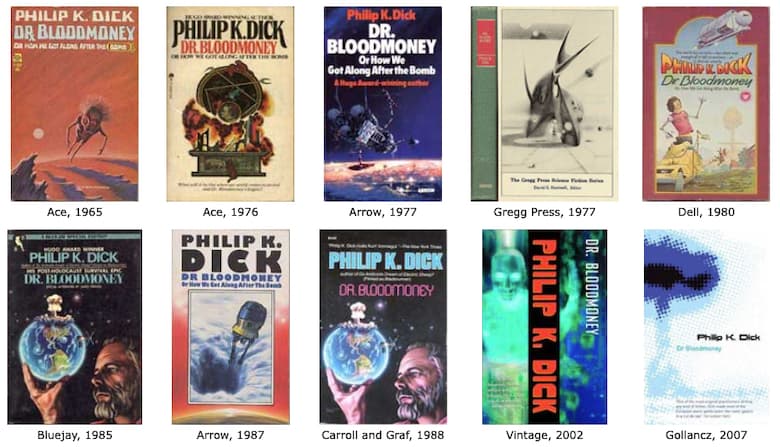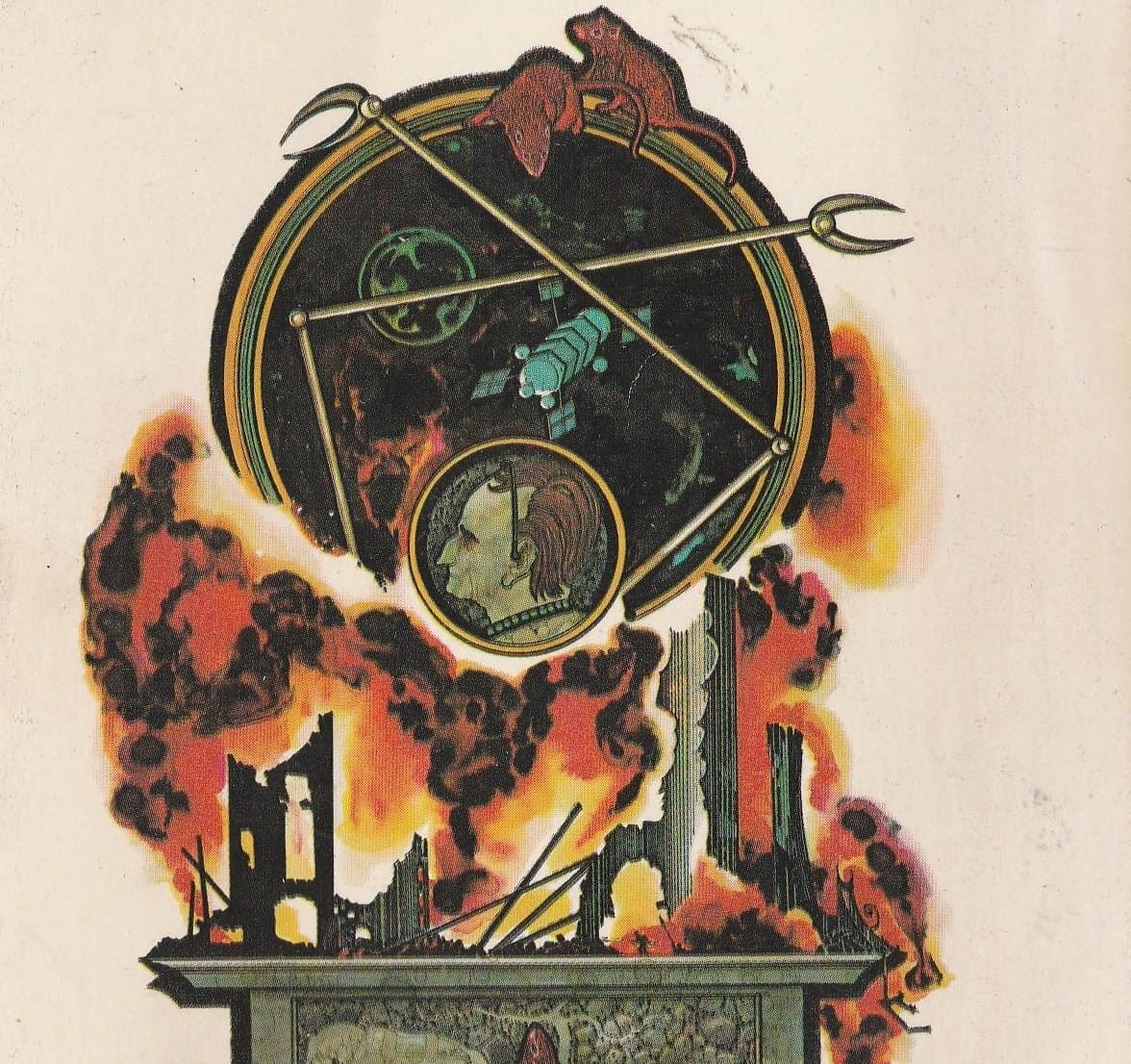Hailed as “The Godfather of Science Fiction”, Phillip Kindred Dick was born prematurely on December 16th, 1928. His twin sister, Jane Charlotte, would die 6 weeks later and leave a profound impact on Philip’s life. Suffering from hallucinations and a slippery grip on reality, he would also be forever haunted by the absence of a sibling. The concept of a “phantom twin” and estranged siblings would surface throughout his critically acclaimed writing career. Most notable of these: Philip K. Dick’s Dr. Bloodmoney or: How We Learned to Get Along After the Bomb.
In a letter written to Sandra Miesel in 1970, Dick admitted that he liked this novel more than anything else he had ever written.
The Bomb Will Bring Us Together
Composed on the heels of the Cuban missile crisis, Philip K. Dick’s Dr. Bloodmoney imagines the early 80’s in California’s Bay Area as an age of fear. A paranoia of atomic weapons and fallout after a failed nuclear defense experiment. The Bluthgeld Disaster of ’72, so named after the overseeing physicist that had made a miscalculation, resulted in mass destruction and radiation poisoning. In his signature style of a disjointed narrative, Dick’s novel begins by introducing multiple characters on the last known day of civilized society.

Beginning with Mr. Jack Tree, the assumed name of Dr. Bruno Bluthgeld. The infamous radiation expert that had made the grave error. Having gone into hiding after the catastrophe, he now suffered from severe paranoia. Guilt and isolation eroding his mind to fabricate delusions of grandeur. Believing he can speak with God and that others read his thoughts. At the suggestion of his friend, Bonnie Keller, he seeks psychiatric help from Dr. Stockstill. Unfortunately, Stockstill disgusted with the incognito scientist, knowing who he really is. Trying to mask his hatred of the patient, he distracts himself by thinking about the NASA Mars launch.
The lone friend of Bruno Bluthgeld is a bored housewife, Bonny Keller. Depressed and repressed, she fears stagnation. Burning through hobbies and meddling in the lives of others to stay busy. With little regard for her husband, Bonny is quite fond of Bruno. Having served as a mentor, she hopes her psychiatrist can help with his mental state. Anxiously she waits by the phone to hear about Bluthgeld and Stockstill’s session. Fantasizing about having affairs or China declaring war. To ease the restlessness, Bonny watches the Mars launch live on television.
Hoppy Harrington suffers from phocomelia, born without arms and legs. He gets around on a government issued cart with extensors. But Hoppy has a powerful mind and is full of ambition. Determined to make a living doing manual labor, he’s hired as a repairman at Modern TV. Quickly he wins over his coworkers with his talents. Concentrating on a broken electronic, he almost seems to heal the device rather than repair it.
Emergency Day
Since the radiation fallout from 1972, mankind has been seeking to thrive beyond Earth. Russia had failed to colonize the moon and the cosmonauts either starved or suffocated. NASA had decided to send a couple into orbit in hopes of colonizing Mars. Walter Dangerfield was selected, an earnest-hearted Regular Joe with his wry and mordant wit. He and his wife Lydia were being sent to pioneer a “Nova Terra”, armed with good breeding genes and a wealth of knowledge. The Dangerfields are a beacon of hope for Earthlings suffering the long-term effects of the Bluthgeld Disaster. Making the opportunity of a fresh beginning more available to everyone tuning in. Until all the screens suddenly go blank, and the signal is lost.
“Walter, we are under attack down here.”
Static begins erasing voices from mission control to the Regular Joe. Helplessly looking down at the blue marble to see matches being lit. Little puffs and flares burning up life.
The only warnings that came were a split-second Red Alert on FM radio. Moments passed before skies darkened and filled with soot. The very ground would jump again and again. Bombs rained upon cities and countryside alike from unknown enemies. People ran wild in the streets, seeking shelter in community cellars. Buildings crumbled and all of Berkley seemed to be sinking on one side, tilting sidewalks, and toppling structures. The survivors would one day reminisce about the event lacking hostility and purpose. As if it was another mistake made in Washington. Militant amateurs and the greedy in their highly scientific circles. Just like in ‘72, when the deranged are in charge it makes the concept of “enemy” unbelievable. Other survivors will recall the relief and excitement felt when the bombs started dropping. If not seen as a second chance to do things over, it was regarded as the will of God. Cleansing away all the undesirable traits of mankind.
The city had become a sieve, leaking endless streams of people wanting to get out. Bruno Bluthgeld wandered the demolished streets of Berkeley, in the midst of chaos. Unable to understand what was happening, just like everyone else. Cars and crowds pushed past him as he slowly recognized this as the end. Surmising that there is no war to speak of other than inside of himself, the responsible party. Bluthgeld believes he brought about this ending with his mind alone. Possessing psychic abilities that cause destruction, just as he had done in ‘72 with the experiment failure. Desperate to make amends, Bluthgeld attempts to will civilization to heal itself from this tragedy.
Crawl Out From the Fallout
When the bombs cease and the smoke clears, society slowly reestablishes itself in smaller colonies. Connecting with a barter system of skills and resources. Slowly they rebuild with primitive methods and little to no machinery. Outside of Berkeley, in West Marin, there are communal gatherings to listen to a lone working radio and the last broadcasts of mankind. Walter Dangerfield, trapped in the Dutchman IV space capsule for the last 7 years, has become an international disc jockey. Endlessly orbiting Earth, entertaining anyone that can pick up his signal. Transmissions of book readings and songs from his music archive. Equipped with the resources to sustain a decade of life for 2, he currently feels unwell. Noticing a sudden appearance of chest pains. Cheerfully, he asks his audience for advice and wonders how much time he has left, as do his listeners. Unable to imagine going on without Dangerfield.

Hoppy Harrington defied all odds and survived Emergency Day. Settling in West Marin, he serves as the capable handy-man and entertains with imitations and juggling. Always seeming to know more than he lets on, Hoppy makes people uncomfortable. Yet the residents were grateful to have him part of the community for his talents. Mechanically inclined and strengthened mental abilities, Hoppy can now move objects with his thoughts. Using these assets to protect residents from thieving outsiders. Psychically lashing out at anyone who underestimates him. Hoppy’s funny impressions can become cruel mocking if his telekinetic gifts aren’t respected.
Bonny Keller defeated stagnation after Emergency Day with her beauty alone. Rising to an unofficial position of power by influence and her many secret affairs. This dangerous hold over her peers has led to the execution of anyone who displeases her. In a spontaneous comfort tryst with a traveling salesman after the bombs fell, Bonny conceived a child. Now 7 years old is the dark eyed little girl named Edie. Unbeknownst to all is her parasitic twin that she calls “Bill”. When she speaks to her brother, it is written off as merely an imaginary friend. But Bill has special abilities too, being stuck between worlds. He speaks with the dead and wants to try and swap consciousness with another creature.
Mr. Jack Tree, formerly known as Bruno Bluthgeld, lives on the outskirts of West Marin as a sheep herder. Twisted with age and more mentally unstable than ever before, protected by Bonny Keller. Once suspecting his cover has been blown, he decides to eradicate all of humanity for good using only his mind. Envisioning black skies and bright flashes in the distance with the smell of smoke on the wind. Hoppy Harrington decides to intervene with his own mental abilities and psychically disposes of the physicist. Indebting West Marin and the rest of the Bay Area to him for sparing all another Emergency Day. But the resident’s gratitude isn’t enough for the telekinetic handy. He wants to be admired like Walt Dangerfield and uses his mind to slowly replace him. Only the little Bill Keller inside of his sister’s abdomen is willing to take on Hoppy Harrington and stop him from hurting people anymore.
Postmodern Pandemic
Philip K. Dick’s Dr. Bloodmoney is considered to be one of the defining science fiction novels of the ’60s. Originally under the working titles “In Earth’s Diurnal Course” and “A Terran Odyssey”, editor Donald Wollheim suggested something different, which is a reference to the 1964 film, Dr. Strangelove or: How I Learned to Stop Worrying and Love the Bomb. Published by Ace Books in 1965, it was nominated for a Nebula Award for best novel but lost to Frank Herbert’s Dune.
— FOUNDATIONS OF HORROR —
Further explore these subgenres & tropes. more>>
#Scifi horror | #Science is Scary | #It’s the End of the World

Reading Philip K. Dick’s Dr. Bloodmoney in the beginning of 2022 is remarkably chilling. Offering ideas of how people come together or move further apart after a major disaster, he blurs the lines of time by referencing actual government officials like Richard Nixon. Other times he gives only vague descriptions that allude to other political figures. While the book is a product of its times, it’s uncomfortable in moments that highlight the unnecessary divisions of humanity. Many of which are still rampant, 57 years later.
Dick noted the desperation of neglected veterans, mental capacities of leaders, and long-term effects of chemical testing. Even giving an uncanny projection of the Challenger tragedy with a simple line of alternate history.
The arrangement of characters and their struggle for a basic understanding echoes current uncertainties of the future. From the horrible realization that everything will change, to the feelings of hopelessness in the face of domestic error and miscalculated response. This all puts the reader in an uneasy state of familiarity, as we enter a 3rd year after Covid’s debut.
Once considered tropes of science fiction and horror are now staples of our modern-day reality. It wouldn’t feel too far-fetched if the next challenges our society faces align with other themes in Philip K. Dick’s existential treatises. Such as government conspiracies, evil corporations, or the entity formerly known as God appearing as A.I. or a cosmic structure.
The futures he contributed to the sci-fi genre beg us to never stop questioning reality and what does it mean to be human? The answers to which are forever evolving in what feels like the beginning of the end.
Additional Reading About Philip K. Dick’s Dr. Bloodmoney
Dr. Bloodmoney Cover Art Gallery
Fun Facts About Dr. Bloodmoney
Last Updated on January 3, 2022.

